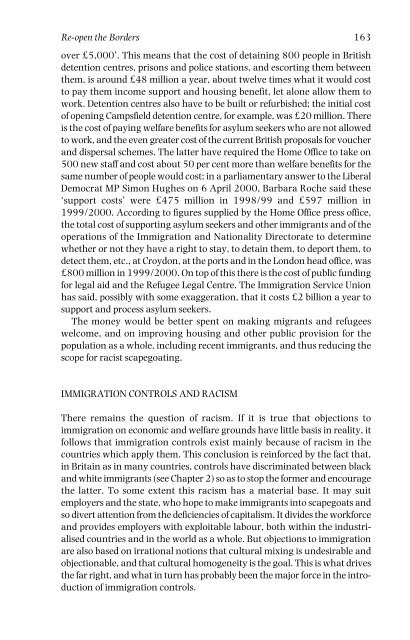Open%20borders%20The%20case%20against%20immigration%20controls%20-%20Teresa%20Hayter
Open%20borders%20The%20case%20against%20immigration%20controls%20-%20Teresa%20Hayter
Open%20borders%20The%20case%20against%20immigration%20controls%20-%20Teresa%20Hayter
Create successful ePaper yourself
Turn your PDF publications into a flip-book with our unique Google optimized e-Paper software.
Re-open the Borders 163<br />
over £5,000’. This means that the cost of detaining 800 people in British<br />
detention centres, prisons and police stations, and escorting them between<br />
them, is around £48 million a year, about twelve times what it would cost<br />
to pay them income support and housing benefit, let alone allow them to<br />
work. Detention centres also have to be built or refurbished; the initial cost<br />
of opening Campsfield detention centre, for example, was £20 million. There<br />
is the cost of paying welfare benefits for asylum seekers who are not allowed<br />
to work, and the even greater cost of the current British proposals for voucher<br />
and dispersal schemes. The latter have required the Home Office to take on<br />
500 new staff and cost about 50 per cent more than welfare benefits for the<br />
same number of people would cost; in a parliamentary answer to the Liberal<br />
Democrat MP Simon Hughes on 6 April 2000, Barbara Roche said these<br />
‘support costs’ were £475 million in 1998/99 and £597 million in<br />
1999/2000. According to figures supplied by the Home Office press office,<br />
the total cost of supporting asylum seekers and other immigrants and of the<br />
operations of the Immigration and Nationality Directorate to determine<br />
whether or not they have a right to stay, to detain them, to deport them, to<br />
detect them, etc., at Croydon, at the ports and in the London head office, was<br />
£800 million in 1999/2000. On top of this there is the cost of public funding<br />
for legal aid and the Refugee Legal Centre. The Immigration Service Union<br />
has said, possibly with some exaggeration, that it costs £2 billion a year to<br />
support and process asylum seekers.<br />
The money would be better spent on making migrants and refugees<br />
welcome, and on improving housing and other public provision for the<br />
population as a whole, including recent immigrants, and thus reducing the<br />
scope for racist scapegoating.<br />
IMMIGRATION CONTROLS AND RACISM<br />
There remains the question of racism. If it is true that objections to<br />
immigration on economic and welfare grounds have little basis in reality, it<br />
follows that immigration controls exist mainly because of racism in the<br />
countries which apply them. This conclusion is reinforced by the fact that,<br />
in Britain as in many countries, controls have discriminated between black<br />
and white immigrants (see Chapter 2) so as to stop the former and encourage<br />
the latter. To some extent this racism has a material base. It may suit<br />
employers and the state, who hope to make immigrants into scapegoats and<br />
so divert attention from the deficiencies of capitalism. It divides the workforce<br />
and provides employers with exploitable labour, both within the industrialised<br />
countries and in the world as a whole. But objections to immigration<br />
are also based on irrational notions that cultural mixing is undesirable and<br />
objectionable, and that cultural homogeneity is the goal. This is what drives<br />
the far right, and what in turn has probably been the major force in the introduction<br />
of immigration controls.


